#my ancestors are probably disappointed I even have an 3d
Explore tagged Tumblr posts
Text
Rex can pry Mexican food from MY COLD FUCKING DEAD HANDS!!!
#my ancestors are probably disappointed I even have an 3d#and can't speak spanish#I'm not gonna refuse to eat my dads food on top of that#☆fortea
6 notes
·
View notes
Text
A Lesson Plan for Videogame Archaeology in the Museum
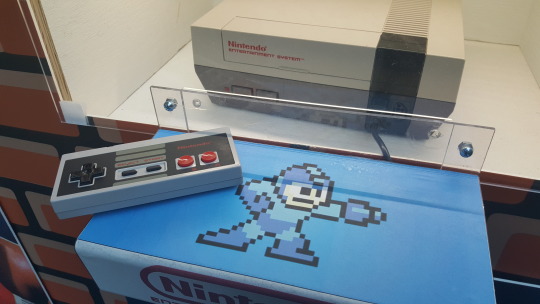
By Adrián Maldonado
I didn’t wake up that morning thinking I’d be playing an original Street Fighter II Championship Edition arcade console in just a few hours. It turned out to be a very good day.
So I was on Long Island recently for our annual, far-too-short family visit to America. It was also my daughter’s second birthday but it was raining and we needed an indoor activity. She loves planes, trucks and trains, and we were assured that the Cradle of Aviation Museum in Garden City has all that plus good hands-on activities and a toddler room. We were not disappointed on any of those fronts.
But unbeknownst to us, the Cradle of Aviation Museum also has a major videogame history exhibition on at the moment. And this was no ordinary rinky-dink travelling exhibit. I’m talking all the consoles, or at least 60 different ones, all playable, alongside some 30 original arcade cabinets. Whose birthday was it again?
It’s been a minute since my last post, so get ready for a nerd onslaught. This post will attempt three things: a straightforward review of a videogame history exhibit; some sense of the wider context within videogame museums I’ve been to recently; and finally, something a bit different: a lesson plan for teaching kids about videogames in the museum. I should probably change the blog title to Things No One Asked For, Ever, but in the meantime, do enjoy the blatant work avoidance.
Capsule review

This exhibit is actually a sequel. It began life as a temporary event called The Arcade Age in December 2015, which focused on recreating the experience of arcade gaming using some 50 playable cabinets. The recreated arcade was only accessible in three daily 90-minute sessions. The layout showed the influence of superhero arcadologist Raiford Guins, who was consulted for this exhibit, in its attention toward recreating the dark, cramped, noisy ambiance of an arcade. Judging by photos of the original exhibit, it also had a cool sideline on related material culture like Street Fighter II action figures and Pac-Man lunchboxes. It originally ran through April 2016, and was then extended to September 2016.
After its success, it was redesigned as a more comprehensive exhibition, From the Arcade to the Living Room: A Video Game Retrospective 1972-1999 in November 2016, now including a full history of home gaming consoles alongside a reduced but still impressive list of arcade cabinets. The website doesn’t say whether this will become a permanent exhibit, but they are selling season tickets for hardcore gamers until December 2017. It was this exhibition I stumbled upon one fateful day in June.
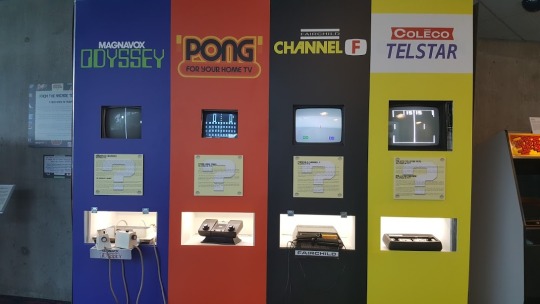
Wall of ancestors
The games are laid out in roughly chronological order, beginning with the carcass of a Computer Space cabinet from 1971 at the start. Curator Seamus Keane has been damn near exhaustive, going beyond the usual focus on ‘Golden Age’ arcade games and providing real working examples of lesser-performing systems like the Neo-Geo and the Atari Jaguar. Fulfilling the dream of a 90s indoor kid, it was perhaps the first and last time I’ll ever play a CD-I and a 3DO (note to me 25 years ago: neither was worth the wait).
Besides the snippets of information provided next to each console, historical context was a bit light and there was no clear aim or agenda for the exhibition. Media surrounding the opening fleshed it out a little more, but not much: for curator Keane, it was “a concept I had in my head of telling what I felt was somewhat of a lost history about the social culture and the popular culture, as well as the technological history of the arcade game itself and of the arcade as a social setting.” Hope you caught all that between rounds of Marvel Vs Capcom.
There were only a few thematic displays but they worked well – a wall of ephemera included a Nintendo Power Pad, several strategy guides and a Game Genie (!). A wall display on the Great Video Game Crash of 1983 included a screen playing the documentary Atari: Game Over (2014) next to an Atari 2600 with an ET cartridge you could load yourself, a crucial part of the home gaming experience you rarely get to experience in a museum setting. A cabinet of dead peripherals was also eye-opening in an unexpected way; the juxtaposition of Sega 3D Glasses and a Sega Dreamcast mouse from a decade apart made me think of how Sega was so often ahead of its time, and yet somehow lost the console wars. In the tech world, it doesn’t always pay to be first.
Videogames in the Museum

Touch the artefacts
I’ve been to several videogame museum exhibitions now (and even some videogame museums!) and can confidently say that this was one of the most fun. There was a wall of NES games and a wall of Atari games, but the core of the arcade was in a long, low-ceilinged dark hall. There, the half-assed display cards dwindled to a minimum and the game was the thing. Original cabinets, many of them with fucked-up decals from years of play, were ready to rock, no MAME here. Aside from the usual Golden Age of Arcade stuff, there were plenty of classic 90s cabinets from my era, and even some left-field entrants like Michael Jackson’s Moonwalker, which I thought was a masterpiece when I first played it in 1990 and has accrued tremendous baggage since then.
Best of all was the chronological row of home gaming consoles buried deep in the bunker-like arcade hall. Here in glowing cubicles of glass but not out of reach were the venerated SNES and Genesis games of my formative years, alongside the also-rans like the Sega Saturn. I showed my 2 year-old daughter her first game of Super Smash Bros for the N64. She picked up the control and held it up to her ear like a phone. I have never loved her more.
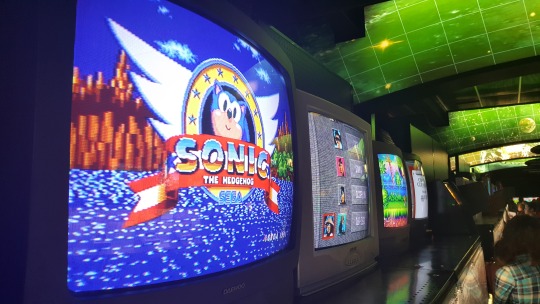
The ragtag army of 90s CRT veterans
Each console was hooked up to a full-on CRT TV, no messing about with flatscreens, as I’ve groaned about previously. As the exhibition website puts it, they are “all on old school TV tubes!” Each TV was different from the next one, as they had clearly been scavenged piecemeal from various Long Island attics. Some had flatter screens, some bulged out lewdly, but all were hard-bitten survivors from the 90s. They are the real heroes here.
How does this rate? While the Computerspielemuseum in Berlin clearly wins out in almost every way in terms of playability, historical context and design, there was something about the scale of the recreated arcade and lack of interpretation here that charmed me. As Guins has pointed out, the material presence of the cabinets and the consoles are part of the gameplay; they are designed to draw you in and beg you to grab them, and whatever their flaws, their physical interfaces shape how the game is played.
Beyond Retro-Nostalgia: A Lesson Plan
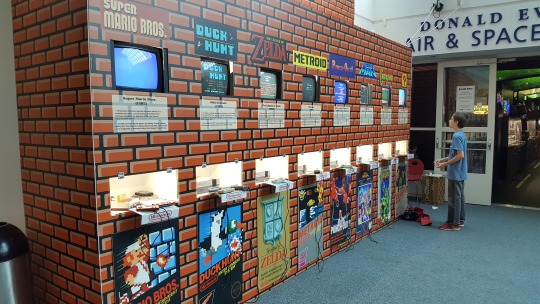
Ready player one
At one point I was able to play technician: I was able to revive a blank TV screen by switching it to channel 3. I felt like a wise elder. I also may have felt very old because I was surrounded by schoolkids. It was a weekday, and we shared the exhibit with a group of fifth-graders (Year 6 for UK readers). For once, it was genuinely interesting to share a museum with a school trip. There have always been children in the videogame exhibitions I’ve visited previously, but they’re always there with their aging nerd parents (of which I am now very much a number). It is certainly worth recording the stories told to a new generation about their cultural heritage. But it was enlightening in a different way to hear what kids said to one another when playing these games.
What I heard blew my mind. I was playing the Double Dragon (1987) arcade cabinet (I’d only ever played the NES version, so this was very exciting indeed), when two boys walked behind me – one of them said to the other, “Double Dragon! I love that game!” How did he know? What else did he know? Has the Internet already made everyone like Wade from Ready Player One? Other kids swapped stories about the games they’d tried, and I felt almost compelled to start writing these candid observations down. They were like little archaeologists unearthing the artefacts of my past and puzzling over what they might mean – but also making more interesting connections with recent games than I could with my nostalgia specs on.
On my way out I ran into one of the schoolteachers and thanked her for taking the kids here, and congratulated her on how well-behaved they all seemed to be even though they were surrounded by a hundred flashing screens. I asked whether this was part of a specific class, and she said no, they usually take the kids to the Cradle of Aviation Museum because science and whatnot, but they dropped into the arcade exhibition because it was there. I asked if they would follow it up in class at all, and she said no.

The Atari Jaguar: and alternate future of 64-bit gaming
That struck me as a bit of a missed opportunity. Here were a few dozen kids having a great time in a museum, handling the technological ancestors of their favourite devices and games. The kids I heard were knowledgeable about videogames, native to them. For all the action in teaching history through videogames, there are no easily accessible resources out there to teach videogames as rare artefacts of a meaningful past. In what other museum exhibition are you allowed to handle, let alone grab and generally get all up in, the archaeology? What better way to learn than by playing?
Don’t get me wrong – museums with videogame exhibitions often provide their own series of educational resources and programmes for school visits, but a quick and very unscientific search shows little coherent agenda for dealing with the historicity of videogame and the material cultures of gaming. As more videogames end up in museums, we do the next generations a real disservice if the whole message is just about how videogames used to be pixellated and now they’re not. The game is not just the visual but the physical, and every console and medium enabled and constrained ways of playing, creating cultures of gaming. To get beyond nostalgia, we need to draw out the untold stories which will engage kids who are playing these objects for the first time.
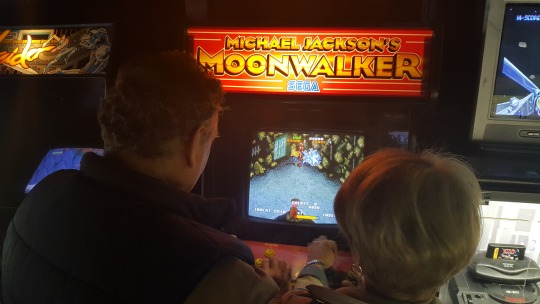
There’s at least a PhD thesis in here
Digital archaeology guru Jeremy Huggett recently reminded us about the need to deal with the historicity of technology: as the workings of our gadgets inexorably disappear into smaller and more efficient packages, we know less about how our devices work, and think little about why they are built the way they are. So break open a few controllers and cartridges to teach the history of computing. We assume a linear progression from worse to better technology on the basis that the invisible hand of the market chose the best products over time. So tell the story of the Sega Dreamcast, recognised for its merits only long after its demise. The market of ideas is always in conflict with the actual market, and real innovation is always pitted against the chance for real profit. Teach the Great Video Game Crash and its mountain of destroyed cartridges; debate the value of excavating the recent past, and what else of theirs will remain to be excavated.
It’s not all about the tech, either. You don’t have to wait for Assassin’s Creed: Cuban Missile Crisis to teach kids about the Cold War and why we’re (still) not playing nice with Russia. You can start with games like Contra and Missile Command and talk about ways in which war found its way even into children’s bedrooms in the 1980s. Maybe have a frank discussion about all those Battlefield games they’re playing now. Play the first ten seconds of Double Dragon to introduce the term ‘toxic masculinity’.
There’s a million ways to sneak learning into a trip to the arcade. Teach the kids how to critically read the artefacts; what could be more archaeological?
More photos here.
Follow us on @AlmostArch
3 notes
·
View notes